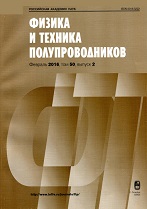|
|
Fizika i Tekhnika Poluprovodnikov, 2016, Volume 50, Issue 6, Pages 854–858
(Mi phts6452)
|
 |
|
 |
This article is cited in 5 scientific papers (total in 5 papers)
Manufacturing, processing, testing of materials and structures
The modification of BaCe$_{0.5}$Zr$_{0.3}$Y$_{0.2}$O$_{3-\delta}$ with copper oxide: Effect on the structural and transport properties
J. G. Lyagaevaa, G. K. Vdovina, I. V. Nikolaenkobc, D. A. Medvedevac, A. K. Demina
a Institute of High-Temperature Electrochemistry, RAS, Yekaterinburg, Russia
b Institute of Solid State Chemistry, Urals Branch of the Russian Academy of Sciences, Ekaterinburg
c Ural Federal University, Ekaterinburg
Abstract:
The effect of the content of CuO additive on the sinterability, phase composition, microstructure, and electrical properties of BaCe$_{0.5}$Zr$_{0.3}$Y$_{0.2}$O$_{3-\delta}$ proton-conducting material is studied. Ceramic samples were produced by the citrate–nitrate synthesis method with the addition of 0, 0.25, 0.5, and 1% CuO. It is shown that the relative density of the samples containing 0.5 and 1% CuO is higher than 94% at a sintering temperature of 1450°C, whereas the relative density of the material is no higher than 85% at a lower content of the sintering additive. From the data of X-ray diffraction analysis and scanning electron microscopy, it is established that the introduction of a small CuO content (0.25%) is inadequate for single-phase and high-dense ceramics to be formed. The conductivity and scanning electron microscopy data show that the sample with BaCe$_{0.5}$Zr$_{0.3}$Y$_{0.2}$O$_{3-\delta}$ + 0.5% CuO composition possesses high total and ionic conductivities as well as a high degree of microstructural stability after hydrogen reduction of the ceramics. The citrate–nitrate method modified by the introduction of a small CuO content can be recommended for the production of single-phase, gas-tight, and high-conductivity electrolytes based on both BaCeO$_{3}$ and BaZrO$_{3}$.
Received: 03.11.2015
Accepted: 18.11.2015
Citation:
J. G. Lyagaeva, G. K. Vdovin, I. V. Nikolaenko, D. A. Medvedev, A. K. Demin, “The modification of BaCe$_{0.5}$Zr$_{0.3}$Y$_{0.2}$O$_{3-\delta}$ with copper oxide: Effect on the structural and transport properties”, Fizika i Tekhnika Poluprovodnikov, 50:6 (2016), 854–858; Semiconductors, 50:6 (2016), 839–843
Linking options:
https://www.mathnet.ru/eng/phts6452 https://www.mathnet.ru/eng/phts/v50/i6/p854
|


| Statistics & downloads: |
| Abstract page: | 38 | | Full-text PDF : | 21 |
|





 Contact us:
Contact us: Terms of Use
Terms of Use
 Registration to the website
Registration to the website Logotypes
Logotypes








 Citation in format
Citation in format 
